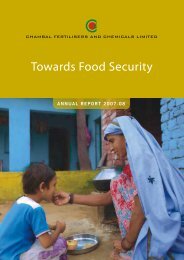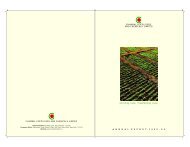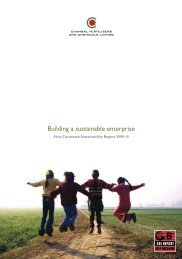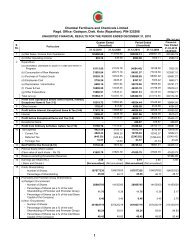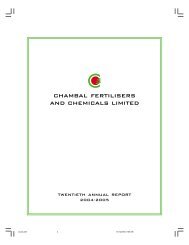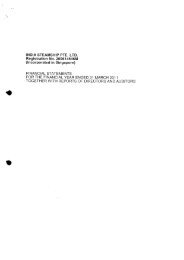Soil Fertility Status - Chambal Fertilisers - Home
Soil Fertility Status - Chambal Fertilisers - Home
Soil Fertility Status - Chambal Fertilisers - Home
Create successful ePaper yourself
Turn your PDF publications into a flip-book with our unique Google optimized e-Paper software.
<strong>Soil</strong> <strong>Fertility</strong> <strong>Status</strong><br />
of North-Western States of India<br />
6. For reclamation of sodic/ alkali soils, use of chemical<br />
amendments viz., gypsum, sulphur etc and for saline<br />
soils, use of organic manures/ green manures coupled<br />
with leaching of soluble salts with water from root zone<br />
should be followed before on set of monsoon.<br />
7. <strong>Soil</strong> conservation measures like leveling, bunding of<br />
fields, cover crop, mulching etc to reduce erosion /<br />
nutrient losses should be practiced.<br />
8. In canal irrigated areas, irrigation water should also be used efficiently so as to avoid secondary<br />
salinisation of soils.<br />
9. Before using tubewell water for irrigation purposes it<br />
should be analysed in <strong>Soil</strong> Testing Laboratory for its<br />
suitability for a particular crop and soil in a particular<br />
region.<br />
10. Adopting crop rotation to maintain soil & crop health.<br />
Crop rotation prevents soil depletion, maintain soil<br />
fertility, reduce soil erosion, control insect-pests, disease<br />
& weeds and also decrease the need for inorganic<br />
supplements.<br />
11. Crop follow periods practices should be adapted to maintain soil fertility. Crop follow periods are<br />
when no crops are planted to allow time for plant to replace the nutrients in the soil. Follow<br />
periods benefits include soil fertility restoration, suppression of weeds & protection of the soil<br />
against erosion.<br />
References<br />
• Chesin, L. and Yien, C.H. (1950). Turbidimetric 2025. National Academy of Agricultural Sciences, New<br />
determination of available sulphates. Proc. <strong>Soil</strong>. Sci. Soc. Delhi, India, PP:91-113.<br />
Am. 14:149-151 • Lindsay, W.L. and Norvell, W.A. (1978). Development of<br />
• Gupta, U.C. (1967). A simplified method for determining DTPA <strong>Soil</strong> test for Zinc, Iron, Manganese and Copper.<br />
Hot Water - Soluble Boron in Podzol soils. <strong>Soil</strong> Sci. <strong>Soil</strong> Sci. Soc. Am. J. 42:421-428.<br />
103:424-428. • Olsen, S.R., Cale, C.V. Watanabe, F.S. and Dean, L.A.<br />
• Hanway, J.J. and Heidel, H. (1952). <strong>Soil</strong> analysis methods (1954). Estimation of available phosphorus in soil by<br />
as used in Lowa State Collage, <strong>Soil</strong> Testing Laboratory, extraction with sodium bicarbonate. Circular No. 939.<br />
Lowa State Collage Bull, 57:1-131.<br />
USDA Washington, DC, USA.<br />
• Jackson, M.L. (1973). <strong>Soil</strong> Chemical Analysis. Prentice • Walkley, A. and Black, C.A. (1934). An examination of<br />
Hall of India Pvt. Ltd., PP:25-214.<br />
different methods for determining soil organic matter and<br />
• Kanwar, J.S. and Katyal, J.C. (1997). Plant Nutrient<br />
a proposed modification of the chromic acid titration<br />
Needs, Supply, Efficiency and Policy Issues : 2000 -<br />
method. <strong>Soil</strong> Sci. 37:29-38.<br />
12



